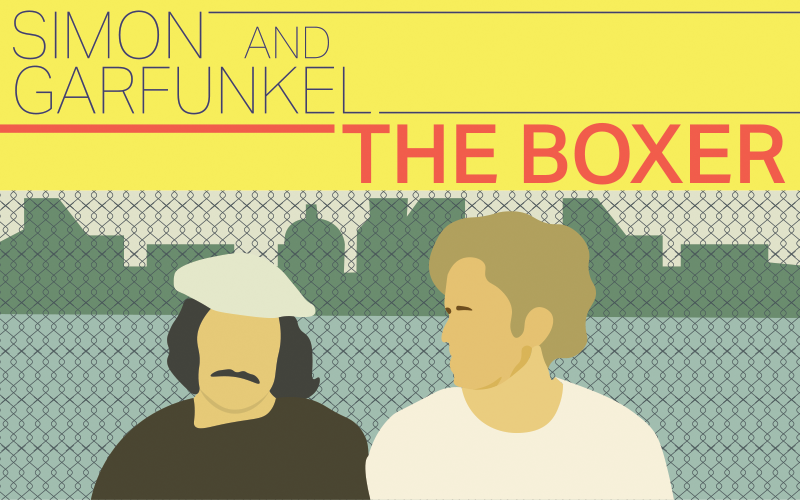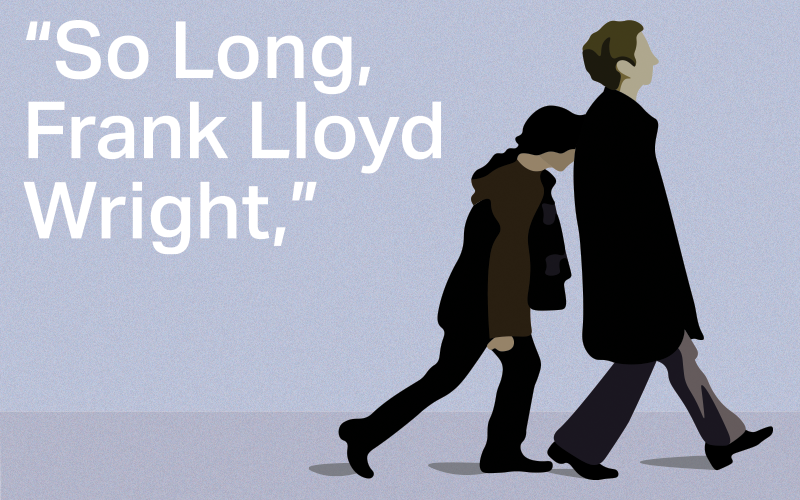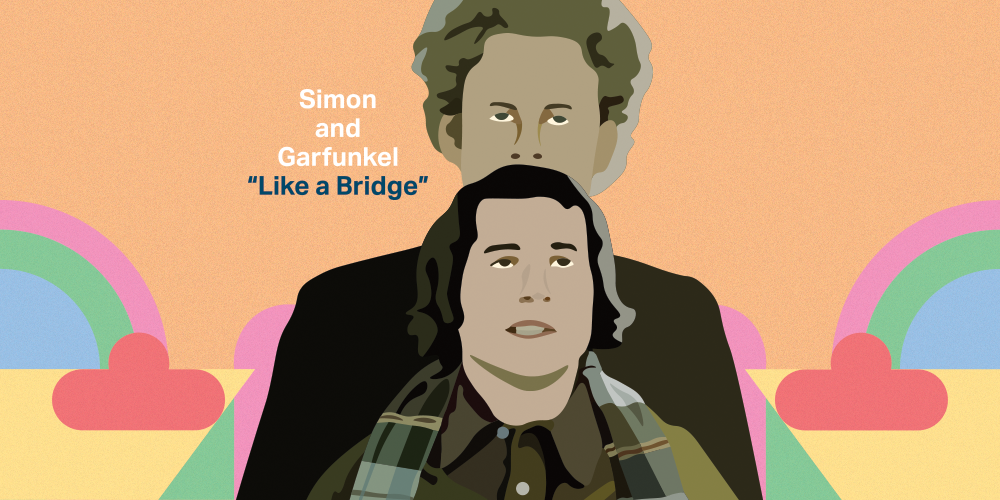Garfunkel never seems to know what to do with his hands. His left thumb is hooked in his jeans’ pocket; his right hand grasps the microphone. It is September 19, 1981, and the duo that was Simon & Garfunkel is reuniting to perform a free concert in Central Park, New York. As the opening piano chords resound through the audience, the camera zooms in on Garfunkel. His face comes into focus — frizzy curls and gentle eyes that gaze out over the crowd.
When tears are in your eyes, I will dry them all
My mother is somewhere in the crowd at the Concert in Central Park. She has just turned 18 the month before and is starting her freshman year at Yale. She remembers taking the train from New Haven to Manhattan with her then-boyfriend. She sat and read Heart of Darkness by Joseph Conrad on a picnic blanket while they waited for the concert to start.
“I have an image of them up on the stage,” she says as I sit with her in her home office. “I don’t remember how long they had been split up then, but it was very exciting that they were playing together; that felt like a big deal. I remember thinking, Paul Simon looks kind of old.”
My mother laughs. “He was probably not even 40, but I was 18 so he seemed old to me.”
Paul Simon was in fact a month shy of 40 when he performed in Central Park. On this day in late November, my mother is 54. For years, she was mistaken for younger than her age — until she stopped dying her hair, which had long since gone grey. Early greying hair is a rite of passage for women in my family. Now, her hair is pure white.
“Sail on, silver girl,” writes Paul Simon in “Bridge Over Troubled Water.” Simon wrote the lyric for his first wife, Peggy Harper, who was distraught one morning after finding her first grey hairs.
Sail on, silver girl
Sail on by
Your time has come to shine
All your dreams are on their way
Simon only wrote this third verse as an afterthought at the suggestion of Garfunkel and the duo’s producer, but it’s my favorite in the song. The lyrics remind me of my mother and my grandmothers and help me feel less anxiety about aging and change. One day, I will find my first grey hairs, and I will hear that lyric and think, “your time has come to shine.”
•
Though it was Paul Simon who wrote “Bridge Over Troubled Water,” Garfunkel sings it alone. Each initially thought that the other should sing the song solo. It was finally agreed that Garfunkel would sing it, his being the stand-out voice of the duo. So, at the Concert in Central Park, he graces the stage alone. Paul Simon sits off to the side, looking uninterested as Garfunkel reaches the climax of the song. Years earlier, in 1972, Simon gave an interview to Rolling Stone Magazine in which he admitted to harboring some resentment over the success of the song, which is irreversibly associated with Garfunkel’s pure tenor.
“Many times I’m sorry I didn’t do it,” he said. “People would stomp and cheer when it was over, and I would think, ‘That’s my song, man. Thank you very much. I wrote that song.’”
•
Growing up, classic Simon & Garfunkel songs like “Mrs. Robinson,” “Cecilia,” and “Homeward Bound” played from the stereo in upstate New York as my brother and I raced salamanders, played board games that ended in fights, and watched our DVD collection of The Andy Griffith Show and Green Acres.
My parents also grew up with Simon & Garfunkel. As a kid in Long Island, my father bought all of the Simon & Garfunkel albums when they came out. He remembers buying the 45 of “Mrs. Robinson” and being scandalized by the lyric “Jesus loves you more that you will know,” because he knew that Simon & Garfunkel, like him, were Jewish boys from New York.
Several hundred miles away, my mother spent summers in Highland Park, Illinois lying on the couch in the living room listening to my grandmother’s LPs. “I remember my best friend Cindy, we used to write in our diaries together when we were ten . . . writing that her dream was to meet Simon & Garfunkel.” She says Garfunkel was probably her favorite; since he was the cuter one. But when Paul Simon’s songwriting and Art Garfunkel’s voice came together, she says, it was “really something special.”
My parents were introduced by mutual friends in 1989. They combined their record collections when they moved in together, so today we have multiple copies of most of the Simon & Garfunkel records, along with some other record collection staples– “Abbey Road,” “Blonde on Blonde,” “Workingman’s Dead.” Many of the records that came from my mom are labeled with her name, but whose copies were whose can often be distinguished just by looking at the record’s condition. Like me, my father has a tendency towards clutter and misplaced keys, and our possessions — from glasses to shoes to records– often show the wear and tear of our “organized chaos.”
I know very little about what it means to be married, but it seems to be something like combining record collections — each person’s catalog of beliefs and neuroses coexisting, overlapping in places and diverging in others. I feel very lucky to have parents whose record collections are still combined 30 years later.
•
Paul Simon and Art Garfunkel grew up three blocks away from each other in the Kew Gardens neighborhood of Queens, New York. Each developed a passion for music early on: as a child, Paul took up the guitar and had a keen interest in jazz and folk, while Art’s instrument of choice was his voice. Garfunkel has described singing in front of his family’s synagogue at age five and finding that he had the power to move congregants to tears. To this day, he considers his voice a gift from God.
They became friends in 1953 at age 11, when they performed together in their school’s production of Alice in Wonderland. They soon grew close and began playing and harmonizing together, emulating their favorite musical group at the time, The Everly Brothers. When they were 15, a promoter for Big Records signed them after overhearing them recording their song “Hey Schoolgirl” at a studio in Manhattan. The duo assumed the name Tom & Jerry–their given names were deemed too ethnic — and “Hey Schoolgirl” was an unexpected success, reaching #49 on the Billboard singles chart in 1957.
After graduating from high school in 1958, Tom & Jerry initially stayed intact while Simon went to study English at Queens College and Garfunkel studied architecture at Columbia University. But their relationship soon fractured when Paul released a solo single, “True or False”. For the next several years, the pair pursued music separately, until they reunited in 1963 with a shared interest in folk music. They performed “The Sound of Silence” at an open mic in Greenwich Village, where they met Columbia Records staffer Tom Wilson, who convinced Columbia to sign them, this time without the monikers. The duo known as Simon & Garfunkel was born.
•
“God, you look great from here,” says Garfunkel. The crowd at Central Park cheers as Art’s eyes shine and Paul plays the beginning notes of “The Boxer.” Art comes in early on the second line of the song, and Paul gives him a teasing smile and an almost imperceptible shake of the head. Then they start to sing again, together.

Now the years are rolling by me
They are rockin’ evenly
I am older than I once was
And younger than I’ll be;
That’s not unusual
Nor is it strange
After changes upon changes
We are more or less the same
After changes we are more or less the same
As they sing the final line of this verse, Paul turns to look at Art. A rare grin erupts across his face as they enter the chorus; he bobs and sways with his guitar. Art puts a hand on Paul’s back. For just a moment, it is 1954. They are 12-year-old boys from Queens, best friends who sing together.
•
My father drives me to the station in Harlem, where I’ll take the train back to college. It’s usually a 45 minute trip from our house in New Jersey, but today the traffic is bad. As we sit in a build-up of cars, counting down the minutes until I miss my train, he suggests that I ask him some questions about Simon & Garfunkel for my piece.
As I start a voice recording, he rests his forearms on the steering wheel and stares out at the snake of honking cars. “I remember with the Bridge Over Troubled Water album, that there was a general understanding that they were breaking up and that this was their last album together. I remember thinking that the song . . . the sound of it and the feeling of it being emblematic of the fact that they were splitting up.” He hums the chorus to “Bridge”; the high notes are outside of his register.
My dad prefers the quieter, more melodic Simon & Garfunkel songs to the upbeat ones. He associates certain songs with different parts of his life, often sad or lonely times. “I think in tenth grade, there was this girl I liked that didn’t like me particularly,” he says, “and I would listen to “Song for the Asking” He pauses again to sing the melody, “Here is my song for the asking . . . ” and I join in with him.
He also tells me that, as a law student, he identified with the song, “I Am a Rock.”
I have my books
And my poetry to protect me
I am shielded in my armor
Hiding in my room
Safe within my womb
I touch no one and no one touches me
I am a rock
I am an island
I’m surprised to learn that my dad, who today tends to strike up a conversation with every stranger he meets, would identify with a song about isolating yourself from the world. My mother once told me that, during the difficult period of her early and mid-20s, meeting my dad worked better than anything else to pull her out of it. Maybe, as they lived separate lives in the same city, they only needed each other.
•
Paul Simon and Art Garfunkel are no longer on speaking terms, reports Rolling Stone in 2016.
“It’s very sad that we don’t talk,” said Garfunkel to American Songwriter in 2020. “Some of his lines kill me. In ‘The Sound Of Silence,’ the fourth verse: ‘Silence like a cancer grows.’ We never speak these days, Paul and I. And yet he wrote, ‘Silence like a cancer grows.’ It’s sad how true it was years later. ‘Bridge Over Troubled Water’ has these things: I’ll be your friend when you’re in trouble. Well, I’m in trouble now that I’m 78, Paul. If Paul is supposed to be my friend, give me a phone call, Paul. Read this American Songwriter interview and give me a phone call . . . It’s been a while.”
* * *
Midway through Simon & Garfunkel’s last tour together in 2010, Garfunkel abruptly lost his gift from God. He was diagnosed with vocal chord paralysis and spent years healing and regaining his voice. The remainder of the 2010 tour was canceled, and the relationship between the childhood friends fractured once again when Simon accused Garfunkel of letting him down by underplaying the problems he was having with his voice. Previous reunion tours had ended similarly: during their 1993 tour, the pair nearly came to blows after Garfunkel accused Simon of encouraging a critic to write a review that dismissed Garfunkel as “just one of a large supporting cast of Mr. Simon’s collaborators and fellow singers.”
In 2018 and 2019, I see both Paul and Art in concert. The Paul Simon concert is part of his Farewell Tour, at an arena in Newark, his birth town. There’s an extensive cast of backup instrumentalists, dancers, and floor-to-ceiling screens. As he plays “Homeward Bound,” a montage of images from his Simon & Garfunkel and solo years plays behind him.
Seeing Art Garfunkel live is very different. The concert takes place in a small theater. He sings Simon & Garfunkel songs and some of his solo songs with very little instrumentation. In between songs, he reads his poetry. At one point, he brushes dandruff from his shoulder and shares a laugh about it with the audience. The clear, angelic voice that Garfunkel is known for is still there, but with less power behind it, and at times he adjusts the melodies to fit his now more limited range.
Over the years, both men have made public jabs at each other. Simon’s impulse to pursue solo work, from his betrayal of the Tom & Jerry duo in 1958 to his decision to leave Simon & Garfunkel behind in 1970, is evidently still a point of bitterness for Garfunkel decades later. Likewise, Simon seems to never have gotten over the attention and praise that “Bridge Over Troubled Water” brought Garfunkel. When he performs it on his Farewell Tour, Simon introduces “Bridge” as his lost child that was stolen from him. In return, Garfunkel has called Simon a monster and a jerk with a Napoleon Complex, even claiming that he only befriended Simon as a child out of pity because he was so short.
Though not without his share of jabs, Paul Simon has been somewhat more private about his relationship with his former bandmate. To understand his side of the story, I’ve looked to his lyrics. In “So Long, Frank Lloyd Wright,” Simon’s combined love letter and goodbye to Garfunkel is hidden behind a thinly-veiled metaphor of another man with a more famous interest in architecture:

I’ll remember Frank Lloyd Wright
All of the nights we’d harmonize ’til dawn
I never laughed so long
So long, so long
Architects may come, and architects may go
And never change your point of view
When I run dry
I stop awhile and think of you
Despite singing much of the song solo on the album, Garfunkel didn’t pick up on the lyrics’ subtext until years later. He later called being tricked into singing his own breakup song “a secretive and unpleasant thing to have done to you.” Another tension between the former friends was added to the pile. Yet, reading Simon’s lyrics, I sense a strong undercurrent of love. Even during the tumultuous final year of Simon & Garfunkel, Simon’s songwriting depicts Garfunkel as a best friend, a soul mate, a creative muse. In their hot-and-cold relationship, I see two proud, perfectionist personalities, perhaps too alike for their own good, who reached a level of fame at a young age that they were unequipped to handle. But beneath the ego clash and the drama, Paul Simon and Art Garfunkel seem to be bound to each other by their shared history and the joy of the music they’ve made together. The thread that joins them wears thin and they drift apart; against all odds, it repairs itself and they come back together again.
•
“Let us be lovers, we’ll marry our fortunes together”
The camera pans to the vast audience, a sea of picnic blankets and bobbing heads. In front of the stage, the people who have been camped out since Friday sway with the music, their arms undulating without rhythm.
Where is my mother in the crowd, with her boyfriend, a nameless and faceless man who lives in her memory but not mine?
I imagine my father, a law student, sheltered within his apartment with his work, while my mother watches this concert a hundred miles away. My brother and I are not even ideas. Maybe my parents think they will have children one day, but to them, it is we who are nameless and faceless.
Kathy, I’m lost, I said though I knew she was sleeping
I’m empty and aching and I don’t know why
Counting the cars on the New Jersey Turnpike
They’ve all come to look for America
Thirty-four years after the concert in Central Park, in 2015, my family drives down the New Jersey Turnpike to visit my grandfather, who has been living alone since my grandmother died in May. It’s the first time I have lost a family member. Last month, my brother left for his freshman year of college. Next year, I will follow him. I have suddenly become aware of time moving forward at an unrelenting pace, my childhood fading in the rearview mirror.
Simon & Garfunkel’s “America” always gives me a sense of yearning. When played as I gaze out the window at the cars passing on the Turnpike, I can believe that the song is about me. We’ve driven this route so many times before, but then my brother was here in the car with us. Then my grandmother was waiting for us in the kitchen.
Like a bridge over troubled water
I will lay me down
From the backseat, I watch my father drive. His driving has gotten more distracted since my grandmother became sick; he leaves his blinkers on and drifts over the rumble strips on the side of the highway. As the traffic slows, my mother places a hand over his on the console. •




